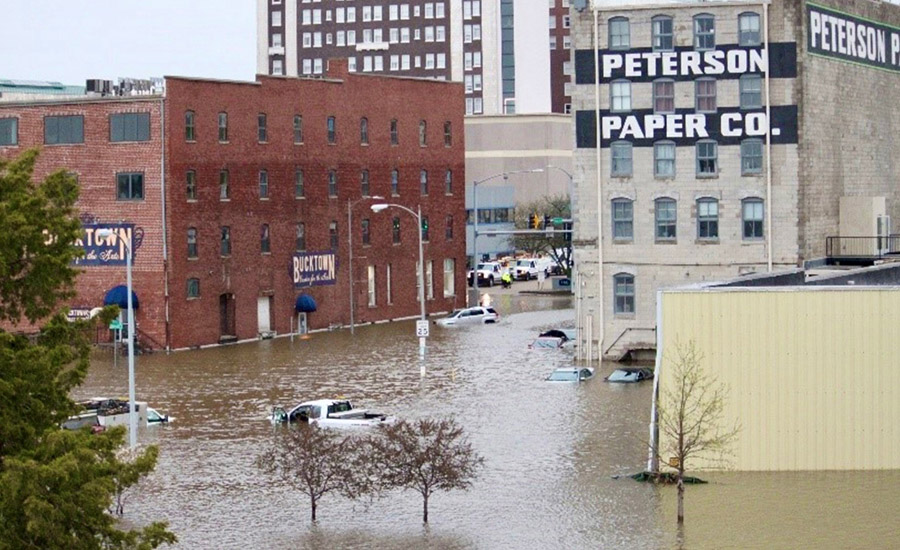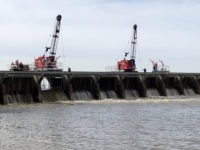Infrastructure
Mississippi River Communities Cope with Flooding—Again

Davenport, Iowa had a record year for flooding in 2019.
Photo courtesy of the Rock Island District
It’s flood season again on the Upper Mississippi River. While flooding this year has been mild so far, studying the trends over the last decade has become a full-time job for Teresa Stadelmann, vice president of H.R. Green, a Cedar Rapids, Iowa-based engineering and design firm.
Also the company's water resources regional manager for Iowa and Minnesota, she is working on three studies to determine options for cities and towns that are struggling with more storms, rising water levels, aging infrastructure and lack of funding. Stadelmann says that 20 years ago, such research was barely a business, but today “It’s keeping me busy.”
The City of Davenport is one of H.R. Green’s customers. It was seriously flooded in 1993, when hundreds of levees failed, and then again in 2008. Since then, flooding has not been annual, but hardly a year goes by without some dangerously high water.
The situation, howeever, is not as bad as it looks, says Clay Merritt, Davenport assistant public works director. “Over the last couple of decades, the city has decided to live with the river," he says. "Davenport has about nine miles along the Mississippi River, the vast majority of which is now riverfront parks. You've probably seen the pictures ... that show huge amounts of flooding, but most of that is parkland.”
One project H.R. Green suggested to the city that made a big difference was rebuilding old storm sewers, some of which were constructed before 1846, when Iowa became a state.
“River Drive, which is a state highway, was always inundated because the river water came up under the storm sewer system,” Merritt says. “We were able to reconfigure the storm sewers in that area and that keeps that intersection open for travel for an extra 4 ft. Now, the river doesn't block the intersection with water until about flood stage at 22 feet. That means we are able to avoid floods impacting travel most of the of time.”
Flooding Where the Mississippi Begins
Flooding caused by late and heavy snow and resulting snow melt inundated portions of northern Minnesota this year. Omid Mohseni, vice president and senior water resources engineer at Barr Engineering, a Minneapolis-based consultant, says weather patterns are changing and that makes predicting floods more difficult. “The most important thing is that the communities are more concerned, and they are asking for more help,” he says. “We are providing more support for different communities with respect to mitigating floods.”
Approaches to flood mitigation are also changing, Mohseni adds. “A lot of green infrastructure is what clients are looking at. Their expectations are not the old ways of just storing and then slowly releasing water. They also want us to come up with designs that are in harmony with the environment, and they aren’t purely looking at flooding events. They want designs that have other benefits for the communities.”
This includes passive protections such as park space and open land designed to drain standing water naturally.
Besides the public sector, Mohseni says his company also has mining and utilities clients that can be heavily impacted by extreme events and runoff.
It’s About the Money
Financing flood mitigation projects is always an issue, says Jonathan Remo, associate professor of geography and environmental resources at Southern Illinois University. His specialties include river science, river management, flood hazard assessment and mitigation.
“We have a flood mitigation system along the Mississippi River that was largely built out in the 1950s and 1960s with mostly federal funds. Today it's been turned over to the locals,” he says.
That means most levee systems along the upper Mississippi River from St. Louis north are locally maintained, usually by local taxing bodies known as levee districts that were created in the aftermath of the Civil War.
If levee and other flood mitigation systems have been well maintained over the years, the U.S. Army Corp of Engineers adds them into the National Levee Safety Program, where there is funding available to repair and build at no cost to local communities. But many communities have not done maintenance for years. Initially, municipalities said it was because they do not believe it is necessary for rare events. As flooding has become more frequent, however, local reasoning has started to shift because communities cannot afford maintenance with budgets allocated to dealing with the events, Remo says.
Some Mississippi River communities still rely on hollowed-out sequoia trees hauled from the West Coast in the 1950s to function as pressure relief wells, he says. Bringing systems like these up to date would cost billions of dollars, and small towns and levee districts in rural areas that lack funding also cannot tax themselves enough to generate it.
Remo sees financing as what keeps this segment of the engineering and design business from being a lot bigger than it is. “Plenty of qualified people would like to do that work, but there’s no money to pay them,” he says.



